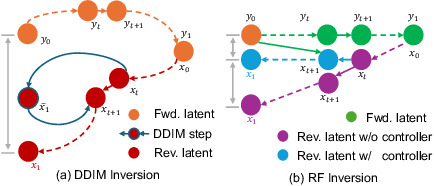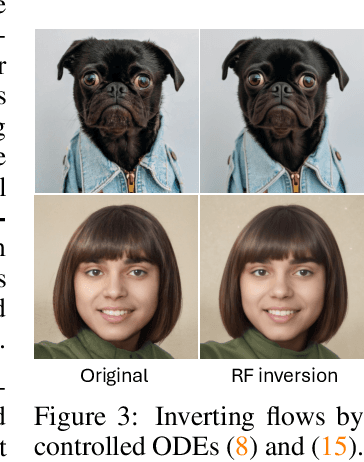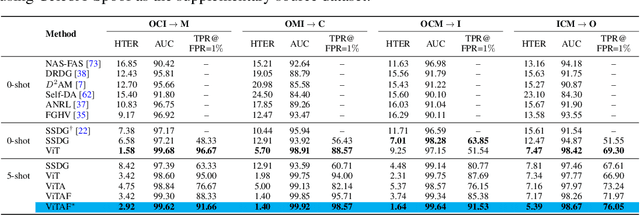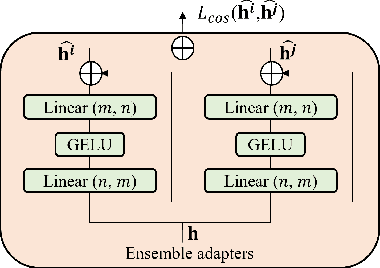Wen-Sheng Chu
SEAL: Semantic Attention Learning for Long Video Representation
Dec 02, 2024Abstract:Long video understanding presents challenges due to the inherent high computational complexity and redundant temporal information. An effective representation for long videos must process such redundancy efficiently while preserving essential contents for downstream tasks. This paper introduces SEmantic Attention Learning (SEAL), a novel unified representation for long videos. To reduce computational complexity, long videos are decomposed into three distinct types of semantic entities: scenes, objects, and actions, allowing models to operate on a handful of entities rather than a large number of frames or pixels. To further address redundancy, we propose an attention learning module that balances token relevance with diversity formulated as a subset selection optimization problem. Our representation is versatile, enabling applications across various long video understanding tasks. Extensive experiments show that SEAL significantly outperforms state-of-the-art methods in video question answering and temporal grounding tasks and benchmarks including LVBench, MovieChat-1K, and Ego4D.
Semantic Image Inversion and Editing using Rectified Stochastic Differential Equations
Oct 14, 2024



Abstract:Generative models transform random noise into images; their inversion aims to transform images back to structured noise for recovery and editing. This paper addresses two key tasks: (i) inversion and (ii) editing of a real image using stochastic equivalents of rectified flow models (such as Flux). Although Diffusion Models (DMs) have recently dominated the field of generative modeling for images, their inversion presents faithfulness and editability challenges due to nonlinearities in drift and diffusion. Existing state-of-the-art DM inversion approaches rely on training of additional parameters or test-time optimization of latent variables; both are expensive in practice. Rectified Flows (RFs) offer a promising alternative to diffusion models, yet their inversion has been underexplored. We propose RF inversion using dynamic optimal control derived via a linear quadratic regulator. We prove that the resulting vector field is equivalent to a rectified stochastic differential equation. Additionally, we extend our framework to design a stochastic sampler for Flux. Our inversion method allows for state-of-the-art performance in zero-shot inversion and editing, outperforming prior works in stroke-to-image synthesis and semantic image editing, with large-scale human evaluations confirming user preference.
RB-Modulation: Training-Free Personalization of Diffusion Models using Stochastic Optimal Control
May 27, 2024Abstract:We propose Reference-Based Modulation (RB-Modulation), a new plug-and-play solution for training-free personalization of diffusion models. Existing training-free approaches exhibit difficulties in (a) style extraction from reference images in the absence of additional style or content text descriptions, (b) unwanted content leakage from reference style images, and (c) effective composition of style and content. RB-Modulation is built on a novel stochastic optimal controller where a style descriptor encodes the desired attributes through a terminal cost. The resulting drift not only overcomes the difficulties above, but also ensures high fidelity to the reference style and adheres to the given text prompt. We also introduce a cross-attention-based feature aggregation scheme that allows RB-Modulation to decouple content and style from the reference image. With theoretical justification and empirical evidence, our framework demonstrates precise extraction and control of content and style in a training-free manner. Further, our method allows a seamless composition of content and style, which marks a departure from the dependency on external adapters or ControlNets.
Beyond First-Order Tweedie: Solving Inverse Problems using Latent Diffusion
Dec 01, 2023Abstract:Sampling from the posterior distribution poses a major computational challenge in solving inverse problems using latent diffusion models. Common methods rely on Tweedie's first-order moments, which are known to induce a quality-limiting bias. Existing second-order approximations are impractical due to prohibitive computational costs, making standard reverse diffusion processes intractable for posterior sampling. This paper introduces Second-order Tweedie sampler from Surrogate Loss (STSL), a novel sampler that offers efficiency comparable to first-order Tweedie with a tractable reverse process using second-order approximation. Our theoretical results reveal that the second-order approximation is lower bounded by our surrogate loss that only requires $O(1)$ compute using the trace of the Hessian, and by the lower bound we derive a new drift term to make the reverse process tractable. Our method surpasses SoTA solvers PSLD and P2L, achieving 4X and 8X reduction in neural function evaluations, respectively, while notably enhancing sampling quality on FFHQ, ImageNet, and COCO benchmarks. In addition, we show STSL extends to text-guided image editing and addresses residual distortions present from corrupted images in leading text-guided image editing methods. To our best knowledge, this is the first work to offer an efficient second-order approximation in solving inverse problems using latent diffusion and editing real-world images with corruptions.
Distributionally Robust Post-hoc Classifiers under Prior Shifts
Sep 16, 2023Abstract:The generalization ability of machine learning models degrades significantly when the test distribution shifts away from the training distribution. We investigate the problem of training models that are robust to shifts caused by changes in the distribution of class-priors or group-priors. The presence of skewed training priors can often lead to the models overfitting to spurious features. Unlike existing methods, which optimize for either the worst or the average performance over classes or groups, our work is motivated by the need for finer control over the robustness properties of the model. We present an extremely lightweight post-hoc approach that performs scaling adjustments to predictions from a pre-trained model, with the goal of minimizing a distributionally robust loss around a chosen target distribution. These adjustments are computed by solving a constrained optimization problem on a validation set and applied to the model during test time. Our constrained optimization objective is inspired by a natural notion of robustness to controlled distribution shifts. Our method comes with provable guarantees and empirically makes a strong case for distributional robust post-hoc classifiers. An empirical implementation is available at https://github.com/weijiaheng/Drops.
Rethinking Domain Generalization for Face Anti-spoofing: Separability and Alignment
Mar 23, 2023Abstract:This work studies the generalization issue of face anti-spoofing (FAS) models on domain gaps, such as image resolution, blurriness and sensor variations. Most prior works regard domain-specific signals as a negative impact, and apply metric learning or adversarial losses to remove them from feature representation. Though learning a domain-invariant feature space is viable for the training data, we show that the feature shift still exists in an unseen test domain, which backfires on the generalizability of the classifier. In this work, instead of constructing a domain-invariant feature space, we encourage domain separability while aligning the live-to-spoof transition (i.e., the trajectory from live to spoof) to be the same for all domains. We formulate this FAS strategy of separability and alignment (SA-FAS) as a problem of invariant risk minimization (IRM), and learn domain-variant feature representation but domain-invariant classifier. We demonstrate the effectiveness of SA-FAS on challenging cross-domain FAS datasets and establish state-of-the-art performance.
Adaptive Transformers for Robust Few-shot Cross-domain Face Anti-spoofing
Mar 23, 2022



Abstract:While recent face anti-spoofing methods perform well under the intra-domain setups, an effective approach needs to account for much larger appearance variations of images acquired in complex scenes with different sensors for robust performance. In this paper, we present adaptive vision transformers (ViT) for robust cross-domain face anti-spoofing. Specifically, we adopt ViT as a backbone to exploit its strength to account for long-range dependencies among pixels. We further introduce the ensemble adapters module and feature-wise transformation layers in the ViT to adapt to different domains for robust performance with a few samples. Experiments on several benchmark datasets show that the proposed models achieve both robust and competitive performance against the state-of-the-art methods.
Solving Inverse Problems with NerfGANs
Dec 16, 2021



Abstract:We introduce a novel framework for solving inverse problems using NeRF-style generative models. We are interested in the problem of 3-D scene reconstruction given a single 2-D image and known camera parameters. We show that naively optimizing the latent space leads to artifacts and poor novel view rendering. We attribute this problem to volume obstructions that are clear in the 3-D geometry and become visible in the renderings of novel views. We propose a novel radiance field regularization method to obtain better 3-D surfaces and improved novel views given single view observations. Our method naturally extends to general inverse problems including inpainting where one observes only partially a single view. We experimentally evaluate our method, achieving visual improvements and performance boosts over the baselines in a wide range of tasks. Our method achieves $30-40\%$ MSE reduction and $15-25\%$ reduction in LPIPS loss compared to the previous state of the art.
Retrieve in Style: Unsupervised Facial Feature Transfer and Retrieval
Jul 17, 2021



Abstract:We present Retrieve in Style (RIS), an unsupervised framework for fine-grained facial feature transfer and retrieval on real images. Recent work shows that it is possible to learn a catalog that allows local semantic transfers of facial features on generated images by capitalizing on the disentanglement property of the StyleGAN latent space. RIS improves existing art on: 1) feature disentanglement and allows for challenging transfers (i.e., hair and pose) that were not shown possible in SoTA methods. 2) eliminating the need for per-image hyperparameter tuning, and for computing a catalog over a large batch of images. 3) enabling face retrieval using the proposed facial features (e.g., eyes), and to our best knowledge, is the first work to retrieve face images at the fine-grained level. 4) robustness and natural application to real images. Our qualitative and quantitative analyses show RIS achieves both high-fidelity feature transfers and accurate fine-grained retrievals on real images. We discuss the responsible application of RIS.
Improved Detection of Face Presentation Attacks Using Image Decomposition
Mar 22, 2021



Abstract:Presentation attack detection (PAD) is a critical component in secure face authentication. We present a PAD algorithm to distinguish face spoofs generated by a photograph of a subject from live images. Our method uses an image decomposition network to extract albedo and normal. The domain gap between the real and spoof face images leads to easily identifiable differences, especially between the recovered albedo maps. We enhance this domain gap by retraining existing methods using supervised contrastive loss. We present empirical and theoretical analysis that demonstrates that the contrast and lighting effects can play a significant role in PAD; these show up particularly in the recovered albedo. Finally, we demonstrate that by combining all of these methods we achieve state-of-the-art results on datasets such as CelebA-Spoof, OULU and CASIA-SURF.
 Add to Chrome
Add to Chrome Add to Firefox
Add to Firefox Add to Edge
Add to Edge